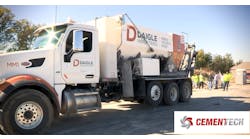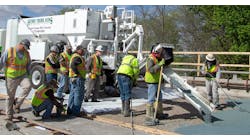By Laura Powers, Contributing Author
Petrographic examination uses techniques borrowed from geology, and it has been applied to investigate concrete performance and concrete-making materials for more than a century.
Petrography relies on microscopes to identify and describe constituents of concrete. It also relies cement knowledge and concrete technology. In the last 60 years, petrographic examination as an investigative tool has expanded and is now available for those who work with concrete on roads and bridges.
Petrographic examinations can identify distress mechanisms in concrete and assess the severity of deterioration. The root cause of distress can be determined or, at the least, potential causes can be ruled out. If petrography cannot definitively determine the cause of distress, it can usually point to other testing that can provide more information. For this reason, petrographic examination is often employed as the first step in a broader engineering investigation.
Petrographic examination has a long history of use by concrete repair contractors. It is less well known that petrography also can be a useful tool in the preconstruction planning phase because it diagnoses problems that arise during construction or later.
Methods of Analysis
Codified in American Society for Testing and Materials (ASTM) standard practice C856, petrographic examinations present a variety of tools, methods, and techniques for systematically examining concrete and assessing properties.
The petrographer chooses the appropriate methods and techniques based on the needs of the project. The ‘workhorse’ tools of the trade are a stereomicroscope for low-magnification viewing of samples and a petrographic microscope (aka polarized-light microscope) for examining prepared thin sections using higher magnifications.
In recent years, scanning electron microscope with X-ray spectroscopy (SEM-EDS) has become a common laboratory tool. SEM-EDS identify the contaminants, examine microstructure, and assess micro-scale changes in chemical composition.
This instrument is particularly suited to investigating distress caused by reactions between the concrete and its service environment. As concrete becomes more complex, incorporating ultra-fine and sometimes novel cementitious materials, routine use of SEM-EDS is increasingly essential.
When investigating damage or distress (its most common application), a petrographic examination begins with collecting information about the concrete structure and determining what questions need to be answered.
The petrographer or an engineer may visit the site to identify the number and location of samples needed for the investigation. Alternatively, the contractor or owner can develop a sampling plan.
The petrographer usually works with core samples, which can be extracted without substantial damage to the sample or to the structure. Other types of samples ranging from powders to 6-inch by 12-inch cylinders to large fragments are not unusual.
In the laboratory, samples are examined and documented in their as-received condition. The petrographer determines how the samples will be prepared for detailed studies that will elicit the information needed to answer the client’s questions.
Samples are cut to intersect important features such as cracks and joints. A lapped or semi-polished section is prepared to show features such as cracks and the size and distribution of aggregates and air voids. Fresh fracture surfaces show paste characteristics, paste-aggregate bond, and other features.
While under the microscope, thin sections and polished sections afford more detailed analysis of the cementitious paste, aggregates, reaction products or secondary products, and microcracks that are too small to be seen without substantial magnification.
The petrographer will photo-document the important features of the concrete, tabulate and interpret the observations, and prepare a report that summarizes the relevant information provided by the client. The petrographer also provides the observations and interpretations that address the client’s questions.
When should you test?
Concrete mixtures are complicated. The construction industry adapts to changes in cementitious materials along with greater use of admixtures, novel additions, and alternative aggregates.
Different placement methods, finishing aids, curing methods, and curing products have been introduced. Innovations in materials and methods bring the involved parties to the table sooner for preconstruction collaboration meetings. When owners, engineers, contractors, and testing agencies meeting, they can minimize risks, identify challenges, and ensure that they are on the same page.
Most contractors collect submittals from their material suppliers. These generally include test reports for the aggregates, certificates for the cementitious materials, and technical data for the admixtures.
Mill certificates and technical data for admixtures are usually taken at face value. The recipient of the information should ensure the reports are current. Chemical analyses and microscopical examination can be performed by the material supplier or by an independent laboratory if verification is needed or contamination is suspected.
The petrographic microscope is a convenient tool for investigating contaminants and pre-hydration in cementitious materials.
Materials testing has been an integral component of preconstruction planning on large projects for many years.
Specifications may call for aggregate petrography (ASTM standard C295) to verify the suitability of the aggregates for use in a particular project. It isn’t unusual for aggregate test reports to consist solely of grading and absorption.
However, many projects have tight limits on certain aggregate characteristics such as content of chert, stain-causing minerals, flat and elongated particles, argillaceous rocks, and other potentially deleterious constituents.
If the aggregate test report does not include this information, a petrographer can evaluate aggregate from current production in accordance with ASTM C295 to assess the suitability of it for use in concrete and determine whether additional testing is warranted.
The petrographer identifies and quantifies potentially harmful rock and mineral types, which includes chemically reactive aggregates as well as those that may be physically unsound. The need to perform any additional aggregate testing can be problematic because certain tests cannot be accelerated to accommodate the construction schedule.
Petrographic examination can also be used to evaluate trial batch mixes that have been prepared to determine the engineering properties of concrete for the project. Trial batch reports usually include compressive strength, density, proportions of constituents, and water-cementitious materials ratio (w/cm).
Slump and plastic air content may be reported. Flexural strength may be measured. These reports often do not receive sufficient attention and should be carefully reviewed for completeness.
Seemingly small changes in proportions of constituents or tweaks to the mixing process can affect the hardened air content of the concrete. The effects on the air-void system may not be apparent in the plastic air content measurement or in the concrete density.
A petrographer can perform a quantitative analysis to measure hardened air content and parameters of the air-void system using the ASTM C457 standard and can assess the distribution of air voids to determine the potential impact on concrete durability.
It is prudent to retain an unbroken cylinder or fragments of a broken cylinder representing the concrete mixture approved for the project. Should the need arise, a petrographer can compare the proportions of components and the composition of the paste in a field sample with the reference cylinder. Laboratory-prepared reference standards may bear little resemblance to the complicated concrete mixtures used in many current projects.
Contractors need to understand the components of the concrete mixture and expected behavior to ensure quality. Important information may be missing simply because no one thought it would be an issue.
Fewer surprises during construction could circumvent the work stoppages needed to investigate problems. Ultimately, having test data for the project in order affords the contractor some protection from liability should the problems occur.
Know Your Materials and Methods
Field mockups may be needed if the project involves new equipment or an unfamiliar method. Petrographic examination of cores from mockups can help determine whether the equipment or methods have achieved the desired result.
Example 1: A contractor with a new screed needed to know whether the new equipment changed the orientation of aggregates near the surface with potentially damaging consequences for the performance of the pavement. Cores taken from concrete placed with the new screed and a reference core taken from older pavement were examined and the aggregate orientation was found to be similar.
Example 2: A contractor was given a choice of three curing aids to use on flatwork in a high-profile project. Mockups were prepared with each product. At 28 days, cores were extracted and petrographic examinations were performed to assess the effectiveness of curing. Detailed microscopical examination using thin section assessed carbonation depth and cement hydration. No substantial differences were observed. The contractor chose the least expensive product.
Expect the Unexpected
While it is hoped that everything proceeds according to plan, nature sometimes has other plans.
Example 1: Workers at a concrete plant noticed a color change in the cement during a major project. A simple microscopical examination comparing a retained sample from the start of the project with a sample of the new cement revealed the new cement was contaminated with fly ash. It was revealed that the fly ash had inadvertently been unloaded into the cement silo. The contractor identified concrete that was placed between the time the fly ash was delivered to the cement silo and the problem was discovered at the plant. Petrographic examination of cores taken from these locations further isolated the concrete that needed to be removed.
Example 2: Deep footings of high-strength concrete were being placed at a site congested with other construction activities. It created intense vibrations, and concerns of damage to the concrete arose. Petrographic examination of cores taken from the footings were analyzed to determine the frequency of microcracking.
It is important to involve the petrographer early in discussions of the encountered problem. A petrographic examination can be performed at any stage of a project. In the project planning stage, aggregate petrography can quantify components that may not be suitable for use in concrete.
Petrographic microscopy of cementitious material powders can identify contaminants and pre-hydration. Petrographic analysis of the air-void system can quantify the hardened air content and calculate the air-void system parameters that are important for durability in cold, moist environments. Assessing the cause of problems that arise during and after construction is the most common application of concrete petrography.
Keys to the effective use of concrete petrography include communication between the contractor and the petrographer, clarity in defining the purpose of examination, suitable samples for analysis, and suitable reference materials for comparison. RB
Laura Powers is a senior project manager at YA Engineering Services.



